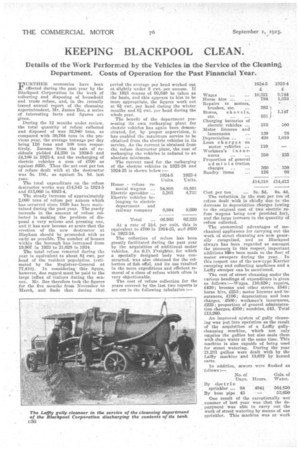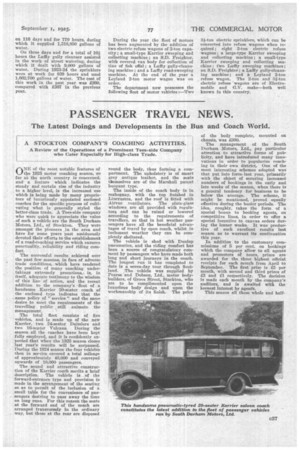KEEPING BLACKPOOL CLEAN.
Page 20

Page 21

If you've noticed an error in this article please click here to report it so we can fix it.
Details of the Work Performed by the Vehicles in the Service of the Cleaning Department. Costs of Operation for the Past Financial Year.
FURTHER economies have been 12 effected during the past year by the Blackpool Corporation in the ivork of collecting and disposing of household and trade refuse, and, in the recently issued annual report of the cleansing superintendent, Mr. James Bee, a series of interesting facts and figures are given.
During the 12 months under review, the total quantity of refuse collected and disposed of was 32,940 tons, as compared with 30,764 tons in the previous year, the average tonnage per day being 116 tons and 108 tons respectively. Income from the sale of residuals yielded £4,250 in 1924-5 and £4,100 in 1923-4, and the recharging of electric vehicles a sum of 1700 as against £650. Thus the net cost per ton of refuse dealt with at the destructor was 5s. 166., as against 5s. 8d. last year.
The total expenditure on the refuse destructor works was £14,545 in 1924-5 and £13,066 in 4923-4.
The steady increase of approximately 2,000 tons of refuse per annum which has occurred since 1920 has been maintained during the past year. The yearly increafie in the amount of refuse collected is making the problem of disposal a very serious and pressing one, and it has now become so acute that the erection of the new destructor at Bispham should be proceeded with as early as possible. The number of houses within the borough has increased from 19,907 in 1923 to 21,628 in 1924.
The total refuse rernoted during the year is equivalent to about 8-1 cwt. per head of the resident population (estimated by the Registrar-General at 77,410). In considering this figure, 'however, due regard must be paid to the large influx of visitors during the season. Mr. Bee therefore took the figures for the five months from November to March, and finds that during that
period the average per head worked out at slightly under 8 ewt, per annum. If the 1921 census of 99,640 be taken as the basis, and this appears to him to be more appropriate, the figures work out at 6i cwt. per head during the winter months and 61 cwt. per head during the whole year.
The benefit of the department possessing its own recharging plant for electric vehicles has again been demonstrated, for, by proper supervision, it has enabled the maximum service to be obtained from the electric vehicles in its service. As the current is obtained from the refuse destructor plant, the cost of recharging the vehicles is reduced to an absolute minimum.
The current used for the recharging of the electric vehicles in 1923-24 and 1924-25 is shown 13.2low:— Total ... 66,905 62,223 At a rate of 20. per unit, this is equivalent to £700 in 1924-25, and £650 in 1923-24.
The collection of refuse has been greatly facilitated during the past year by the acquisition of additional motor vehicles. An S.D. Freighter, for which a specially designed body was constructed, was also obtained for the collection of fish offal, and its use resulted in the more expeditious and efficient removal of a class of refuse which often is very objectionable.
The cost of refuse collection for the years covered by the last two reports is set out in the following tabulation : The reduction in the cost per ton of refuse dealt with is chiefly due to the decrease in depreciation charges (owing to the original cost of two electric refuse wagons being now provided for), and the large increase in the quantity of refuse collected.
The economical advantages of mechanical appliances for carrying out the work of street cleansing are now generally • recognized, and as Blackpool always has been regarded as amongst the pioneerl in this respect, important additions h%re been made to the fleet of motor sweepers during the year. .In this respect one of the new-type Karrier sweeping and collecting machines and a Laffly sweeper can be mentioned.
The cost of street cleansing under the various headings of expenditure is given as follows :—Wages, £10,820; repairs, £420; brooms and other stores, £543; horse hire, 1253; motor licences and insurances, £106; depreciation and loan charges, 1500; workmen's insurances, £225; proportion of general administration charges, £350; sundries, £43. Total 113,260.
An improved system of gully cleansing was put into operation as the result of the acquisition of a Laffiy gullycleansing machine, which not only empties the gullies but also seals them with clean water at the same time. This machine is also capable of being used for street watering. During the year 21,231 gullies were dealt with by the Laffly machine and 19,679 by horsed carts.
In addition, sewers were flushed as follows :— No. of Gals. of Days. Hours. Water. By electric , sprinkler ... 84 494-i 564,850 By hose pipe 43 — 53,650 One result of the exceptionally wet summer of last year was that the department was able to carry out the work of street watering by means of one sprinkler. This machine was at work
on 116 days and for 770 hours, during which it supplied 1,318,850 gallons of water.
On three days and for a total of 101 hours the Laffiy gully cleanser assisted in the work of street watering, during which it dealt with 9,000 gallons of water. During 1923-24 the sprinklers were at work for 939 hours and used 1.662,700 gallons of water. The cost of this work in the past year was £260, compared with £367 in the previous year. During the year the fleet of motors has been augmented by the addition of two electric refuse wagons of 2-ton capacity; a small-type Karrier sweeping and collecting machine ; an S.D. Freighter, with covered van body for collection of tins of fish offal ; a Left gully-cleansing machine ; and a Laffly road-sweeping machine. At the end of the year a Leyland 2-ton motor wagon was on order.
The department now possesses the following fleet of motor vehicles :—Two
3f-ton electric sprinklers, which can be converted into refuse wagons when required; eight 2-ton electric refuse -wagons ; a large-type Karrier sweeping and collecting machine ; a small-type Karrier sweeping and collecting machine ; Iwo Deily sweeping machines; an S.D. Freighter ; a Daftly gully-cleansing machine ; and a Leyland 2-ton refuse wagon. The 2-ton and 3f-ton electric refuse "wagons are of Electromobile and G.V. make—both well known in this country.




























